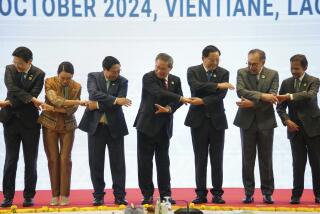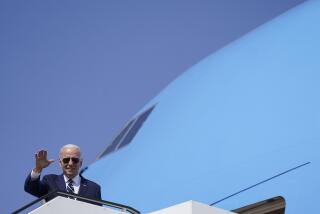China Works to Improve Relations With Southeast Asian Neighbors
- Share via
PHNOM PENH, Cambodia — China is stepping up its activities in Southeast Asia, seeking to reassure uneasy governments about its ambitions in the region while signing a flurry of agreements to provide military and developmental assistance.
On Monday, Chinese President Jiang Zemin arrived here after a weekend stop in Laos. He was the highest-ranking Chinese official to visit Cambodia in 37 years and left just two days before President Clinton is scheduled to tour neighboring Vietnam. He flew on to Brunei on Tuesday, where he and Clinton are attending Asia-Pacific Economic Cooperation meetings.
Jiang was greeted here by 200,000 waving children who lined the six-mile route from the airport and by banners hanging over Russian Boulevard that proclaimed the “bons of solidarity friendship” between China and Cambodia. King Norodom Sihanouk, 78, who spends most of his time in Beijing and receives a generous stipend from the Chinese government, hailed Jiang’s overtures to Southeast Asia and his $13-million aid package for Cambodia.
Since the region was struck by an economic crisis in 1997, China has signed cooperative agreements with eight of the 10 countries in the Assn. of Southeast Asian Nations, or ASEAN. It has settled a border dispute with Vietnam, become a major arms provider to Myanmar, helped build a television satellite receiving station and a hydroelectric power plant in Laos, and patched up relations with Cambodia, long frayed because of Beijing’s support for the murderous Khmer Rouge regime in the 1970s.
Political analysts agree that Beijing’s relations with Southeast Asia have dramatically improved. Vietnamese Prime Minister Phan Van Khai, whose nation fought a border war with China in 1979, describes the two nations’ ties as the “best ever.”
Even Thailand, nervous about China’s goals, has been a beneficiary: When it fell into recession in 1997 and felt largely ignored by its longtime allies in Washington, the Thai government found China on its doorstep with a $1-billion loan.
But with the exception of the generals who run Myanmar, Southeast Asia isn’t sure that China is the benign protector it claims to be and worries about Beijing’s growing military and economic clout. Of particular concern is the possibility that China’s entry into the World Trade Organization, expected in the coming months, will siphon foreign investment from a region that also depends on low-cost labor to attract foreign firms.
“Frankly,” Philippine President Joseph Estrada said in a recent interview, “I think China wants to take over Asia.”
Beijing claims sovereignty over the South China Sea and the Spratly Islands, a chain in the strategic navigation lanes that link the Indian and Pacific oceans. China’s need for electric power has led to the construction of dams on the upper Mekong River that are being built without consulting downstream ASEAN countries that will be affected.
Southeast Asian nations also remember well China’s past support of communist insurgencies in Malaysia, Indonesia, Singapore, Thailand and the Philippines. The fear of those insurgencies was, in fact, a prime catalyst for ASEAN’s founding in 1967.
“Southeast Asia is in no position to deal with any moves by China at the moment because it is still struggling with its own internal problems,” said Bruce Gale, an independent political analyst in Singapore. “There are weak presidents in the Philippines and Indonesia and continued uncertainty over how the Thai elections will play out. Malaysia seems more stable now, though even there, there is still some unease.”
But Gale and others note that China has become a net importer of oil for the first time and needs regional stability and open shipping lanes to realize its economic potential. If for no other reason, it is to Beijing’s advantage to encourage the peaceful development of ASEAN member states, whose populations include 40 million ethnic Chinese with combined wealth estimated at $200 billion.
The United States, the dominant non-Asian power in the region, shares that need for stability. According to a study by the Rand Corp. of Santa Monica, two-way trade between ASEAN and the U.S. was worth nearly $120 billion last year. Additionally, direct U.S. foreign investment in Southeast Asia shot from $11.8 billion in 1990 to $37.5 billion in 1997, surpassing U.S. investments in either Japan or Brazil.
“I think ASEAN countries are realistic enough to know that in the near term, China does not threaten the region,” said Chaiwat Khamchoo, a political scientist at Chulalongkorn University in Bangkok, Thailand.
“Certainly stability is in China’s interest because it will promote growth, but when it comes to China’s long-range interests, Southeast Asia still harbors a lot of suspicion.”
More to Read
Sign up for Essential California
The most important California stories and recommendations in your inbox every morning.
You may occasionally receive promotional content from the Los Angeles Times.













